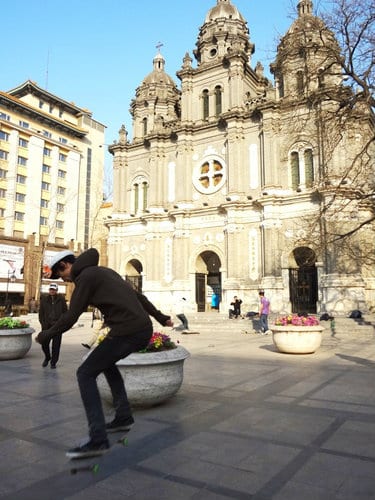I remember the last time I was in Wangfujing. It was a cold, uncommonly clear day and I was looking for a tailor, tracing steps recalled from dusty memories conveyed across generations. Wangfujing is not a place you would expect to find a tailor. A stop on the oppressively crowded Line 1 of the Beijing subway, Wangfujing is a pedestrian shopping street with brand names from Gucci to Hermes, and every Chinese chain store imaginable. The history of Wangfujing extends back over 500 years, but in a testament to China’s rapid development, only in the past decade was it closed to traffic and transformed into a flashy, crowded, international shopping destination.
In the 1970’s, clusters of Wangfujing were filled with tailors and watchmakers, small vendors and family operations working out of the boxy concrete buildings that still stand today. Back then, when my mother was preparing for a high school interview, her family sent her to find a tailor in the alleys of Wangfujing. She still remembers the girl who made her skirt – one out of a long line of girls her own age, heads bent over their sewing machines. The girl had come from the countryside to make a bit of money in the city. The skirt she made for my mother fit perfectly – and my mother still wears it today.
In Wangfujing last winter, I thought maybe the tailors would still be there, clustered in a building or perhaps an alley with a line of little family-owned shops. I needed a skirt for upcoming job interviews, and had been sent there at my mother’s recommendation. But she was remembering the Wangfujing of several decades past, before she had moved to the United States.
The Wangfujing I know is a place where tourists go to shop and snap pictures at the night market, which features exotic snacks like fried scorpions and seahorses. Wangfujing is where skateboarders and other young Chinese loiterers gather, in the plaza in front of St. Joseph’s Church. The cathedral has been there since the 1600s, when Wangfujing was still young. Needless to say, I didn’t find any tailors that day. I gave up searching and hung out with the skateboarders in the plaza, and wondered what the eye-like window of the cathedral has seen in the passing years.


![[Only in Beijing] Wangfujing Memories<!--:zh-->[仅在北京] 王府井回忆](https://www.oneinabillionvoices.org/wp-content/uploads/2012/11/Wangfujing-memories.jpg)
